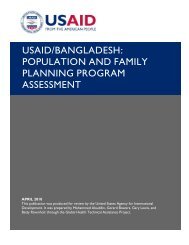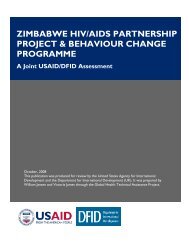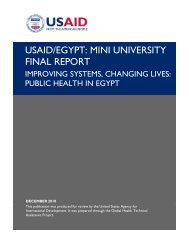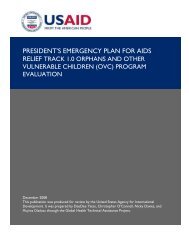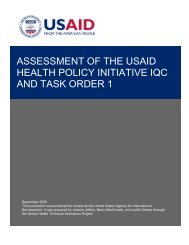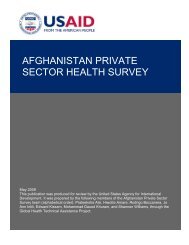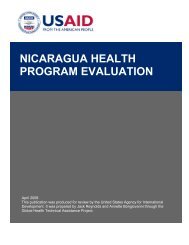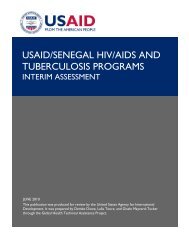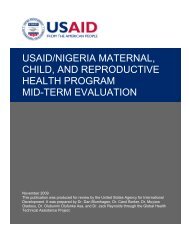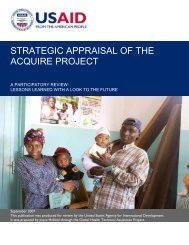usaid/ethiopia pepfar mid-term evaluation of the ... - GH Tech
usaid/ethiopia pepfar mid-term evaluation of the ... - GH Tech
usaid/ethiopia pepfar mid-term evaluation of the ... - GH Tech
- No tags were found...
You also want an ePaper? Increase the reach of your titles
YUMPU automatically turns print PDFs into web optimized ePapers that Google loves.
2. HCs need trained data managers. Data management involves more than recording information inlogbooks and on reporting forms. The inability <strong>of</strong> many HCs to collect and summarize essentialdata for <strong>the</strong> <strong>evaluation</strong> team pointed out a serious deficiency in data management at <strong>the</strong> locallevel. In some cases, data clerks assigned to HCs had no idea how to summarize or evaluate <strong>the</strong>health data <strong>the</strong>y were recording. Given <strong>the</strong> importance <strong>of</strong> data being collected, training in basicdata management should be an essential component <strong>of</strong> IMAI.3. Data entry and management at <strong>the</strong> HC level should be computerized. Obtaining data from HCs for <strong>the</strong><strong>evaluation</strong> team required counting and hand tabulation from logbooks. Computerization <strong>of</strong> datawill facilitate <strong>the</strong> ability <strong>of</strong> HCs to summarize and analyze locally generated data. Decisions willneed to be made about <strong>the</strong> appropriate level <strong>of</strong> hardware and s<strong>of</strong>tware supplied to HCs, whichideally should be uniform to allow for transfer <strong>of</strong> data to higher levels for reporting and analysispurposes. Moving toward computerization will also require <strong>the</strong> availability <strong>of</strong> informationtechnology support staff, computer supplies, maintenance contracts, and o<strong>the</strong>r services to permitsustainability. The <strong>evaluation</strong> team believes that this is a worthwhile investment that should beencouraged throughout <strong>the</strong> HC system.G. Partnering with O<strong>the</strong>r Agencies and Organizations to Promote IMAIUSAID should partner with o<strong>the</strong>r agencies and organizations to promote IMAI and maximize availableresources. It would be extremely difficult for any single agency, even with <strong>the</strong> generous support that<strong>the</strong> U.S. government has allocated to this program, to address all <strong>of</strong> <strong>the</strong> issues contained withinthis report. USAID is joined by a number <strong>of</strong> partner organizations in E thiopia that are alsointerested in expanding HIV prevention, care and treatment. These include (but are not limitedto) WHO and UNAIDS, o<strong>the</strong>r U.S. organizations such as CDC and <strong>the</strong> National Alliance <strong>of</strong> Stateand Territorial AIDS Directors, E uropean and o<strong>the</strong>r organizations, <strong>the</strong> International Center forAIDS Care and Treatment Programs (Columbia University), Johns Hopkins University, <strong>the</strong>International Training and E ducation Center on HIV (University <strong>of</strong> Washington), implementingorganizations such as MSH, E thiopian and o<strong>the</strong>r nongovernmental and community-basedorganizations, and most importantly, <strong>the</strong> E thiopian government and Ministry <strong>of</strong> Heath. WHO isclearly a critical partner in implementing IMAI. IMAI represents a strategy developed incoordination with and promoted by WHO, and WHO has produced many <strong>of</strong> <strong>the</strong> tools and guidesrelated to both IMAI and IMCI. The team spent a number <strong>of</strong> hours with WHO representatives inAddis as well as during its local visits to various regions, and was impressed by <strong>the</strong> knowledge <strong>of</strong><strong>the</strong>se representatives concerning IMAI and o<strong>the</strong>r issues related to HIV/ AIDS, as well as <strong>the</strong>iroverall commitment to ensuring its overall objectives. USAID should work closely with WHO asa full partner in follow-up discussions <strong>of</strong> how to best address <strong>the</strong> issues raised in this <strong>evaluation</strong>.USAID should also work closely with o<strong>the</strong>r implementing partners, including <strong>the</strong> E thiopianMinistry <strong>of</strong> Health, MSH, and CDC. MSH is <strong>the</strong> currently identified implementing partner formany IMAI-related activities such as <strong>the</strong> clinical mentoring program.To help maximize utilization <strong>of</strong> limited resources, USAID may want to evaluate how all fundsrelated to PE PFAR (including those for staffing, foreign consultants, contracts, and directsupport for local care and treatment activities) are allocated. It may be possible to identifyadditional funds that can be used to provide greater support for local activities to help implementsome <strong>of</strong> <strong>the</strong> recommendations contained within this report. In follow-up discussions <strong>of</strong> how tobest address <strong>the</strong> issues raised in this <strong>evaluation</strong>, USAID will also need to work closely withmultiple partners to de<strong>term</strong>ine how to best collaboratively address <strong>the</strong> many critical issues thatIMAI HIV/ AIDS in E thiopia present. If this report helps to define what <strong>the</strong> most importantchallenges are for IMAI, and assists with <strong>the</strong> continued development <strong>of</strong> comprehensive andMid-<strong>term</strong> Evaluation <strong>of</strong> Ethiopia IMAI Program 51




